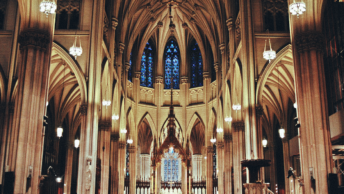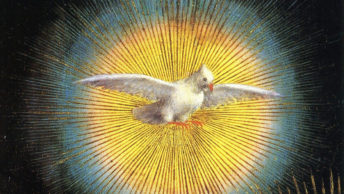I once knew an older woman whose favorite color was red. Her first-ever car was a red convertible; when she wore lipstick, it was always bright red, instead of a softer shade, and when watching football on TV, if one team was wearing red uniforms, that was the team she rooted for. Red fit her very well, for she had a forceful and direct personality, and could dominate a room full of people without even trying. The color red gets our attention. That’s why it’s used in stop signs and traffic lights, and is often the color of fire trucks and ambulances. Just over a week ago many people gave their attention to the night-time sky, watching streaks of red associated with the northern lights, or aurora borealis. Red can symbolize problems or things to be corrected. Most teachers use red ink to correct homework and exams, and accountants speak of red ink when referring to budget shortfalls. Red can frequently be a warning of danger, such as the term “red alert.” The actors Bruce Willis and Mary Louise Parker once starred in a movie about former CIA agents; it was called RED, which stood for “Retired and Extremely Dangerous.” On the other hand, red is used as a color of love on Valentine’s Day, and when husbands buy their wives flowers, their choice is usually a dozen red roses.
Red has always been an important color in the life of the Church. Because it’s the color of blood, we use it on Good Friday, when Jesus died on the Cross, and on Palm Sunday, when read the account of His Passion. We also use red on the feast days of martyrs, who shed their blood by dying in the Name of Jesus—including all the apostles, except for St. John. Centuries ago the Church’s cardinals began wearing red robes as a symbol of their willingness to die for the Faith. In the missal, or prayer book, the priest uses at the altar, the prayers themselves are printed in black ink, but the rubrics, or directions for the priest to follow while saying Mass, are printed in red. The sanctuary lamps, whose burning candles indicate that the Eucharistic Jesus is present in the tabernacle, are made of red glass. The altar wine—which, when consecrated, becomes the Blood of Christ—is normally red in color. Above all, the Church uses this as the color of the Holy Spirit, since red represents power, love, and warmth. The Holy Spirit is all-powerful and extremely dangerous to satan and his minions, and capable of overturning this world’s false authorities and values. For the children of God, however, the Spirit warns us of spiritual danger, draws our attention to important religious realities and truths, and fills us with the warmth of Divine Love. That’s why Pentecost, along with Christmas and Easter, is considered the greatest and most important of the Church’s solemnities or feast. As such, it provides us a wonderful opportunity to renew our discipleship in Christ by opening ourselves to the fullness of His Spirit.
The Holy Spirit is present and active whenever our world, our Church, or our lives need to be shaken up and renewed—and this process often occurs in surprising and unexpected ways. The Acts of the Apostles describes how, after the apostles received the Spirit, they were able to preach so that people from many different languages and nations miraculously understood them; this unity in the truth is presented as the undoing of the confusion that occurred at the Tower of Babel, when different languages became a source of division and strife. Jesus promised His disciples that the Holy Spirit would come for the forgiveness of sins and to guide them into the truth that leads to eternal life—and through the ministry of the Church, this saving promise continues to unfold down to our own day. By means of Baptism and Confirmation, we are enabled and empowered by the Spirit to bear witness to Jesus in humble, courageous, and compelling ways, and thus make a real difference in the world.
Someone once noted that deep sea divers always go into the water with oxygen tanks strapped to their backs—for the simple reason that water is not our natural element; because we human beings can only hold our breath for so long, we need assistance in breathing if we’re beneath the surface of the waves for any length of time. For true Christians, the Holy Spirit is the “oxygen” we need in order to make our way through life while living in an alien and sinful world filled with alluring but dangerous temptations and attractive but false religious values (Tony Evans’ Book of Illustrations, p. 151). Many people drown or get lost in a spiritual sense because they are not trying to know and follow the Lord’s plan for their lives. If we are true followers of Jesus, this will never happen to us—for His Spirit will fill us with joy and peace, warn us of spiritual dangers and falsehoods, strengthen and console us in our sufferings, unite us with others who share and support our beliefs and values, and help us discover and fulfill our mission in life. All these blessings and gifts will help us remain true to Jesus as we journey through a world that’s increasingly hostile to the Church and the Gospel.
Red can be a color warning of danger, a color that distracts us and diverts our attention from something more important, or a color representing suffering, pain, and division. However, through God’s grace, red can also stand for courage, strength, confidence, boldness, unity, spiritual life, and the warmth of Divine Love—and all of these things are available to us through the Gifts of the Holy Spirit. May our celebration of Pentecost help us open our hearts ever more deeply to all that the Spirit wishes to do within us and bestow upon us.








